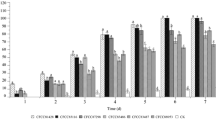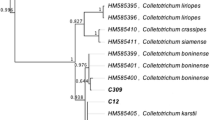Abstract
Among the eight entomopathogenic fungi tested against the termite, Odontotermes obesus (Rambur), five fungal pathogens viz., Beauveria bassiana (Bals.) Vuill,Metarhizium anisopliae (Metsch.) Sorokin var. anisopliae, M.flavoviride Gams Rozsypal var. minus, Paecilomyces lilacinus (Thorn) Samson and P.fumosoroseus (Wize) Brown & Smith, were pathogenic. Three other fungal pathogens viz. Verticillium lecanii Zimm, Paecilomyces farinosus (Holm. ex Gray) and Nomuraea rileyi (Farlow) were not pathogenic. B. bassiana was the most effective pathogen against termites, followed by M. anisopliae, M.flavoviride, P. lilacinus and P.fumosoroseus. Workers minor, of the three morphogenetic forms of O. obesus, were the most susceptible, followed by workers major and soldier caste. Bioassay on isolates of two most virulent termite pathogens, B. bassiana and M. anisopliae revealed that B. bassiana isolate Bapatla was the most effective fungal pathogen with the lowest LC50 (9.98 × 104 conidia/ml)
Résumé
Huit champignons entomopathogènes ont été testes contre les termites Odontotermes obesus (Rambur). Cinq espèces se sont révélées efficaces: Beauveria bassiana (Bals.) Vuill., Metarhizium anisopliae (Metsch.) Sorokin var. anisopliae, M. flavoviride Gams Rozsypal var. minus, Paecilomyces lilacinus (Thom.) Samson et P. fumosoroseus (Wize) Brown et Smith. B. bassiana a été le plus efficace suivi par M. anisopliae, M. flavoviride, P. lilacinus et P. fumosoroseus. Sur les trois morphotypes de O. obesus testés, les petits ouvriers ont été les plus effectés, suivis par les grands ouvriers puis les soldats. Les trois autres champignons pathogènes, Verticillium lecanii Zimm., Paecilomyces farinosus (Holm, ex Gray) et Nomureae rileyi (Farlow) n’ont pas donné de résultat positif. Les essais biologiques sul les isolats obtenus sur les deux entomopathogènes les plus virulents, B. bassiana et M. anisopliae, ont montre que l’isolat B. bassiana Bapatla a été le pathogène le plus efficace avec les valeurs LC50 (9.98 x 104 conidia/ml) et LT50 (83,66hr) les plus faibles.
Similar content being viewed by others
References
Abbot W. S. (1925) A method of computing the effectiveness of an insecticide. J. Econ. Entomol. 18, 265–267.
Agarwal V. B. (1975) Studies on the biology and ecology of mound building termites, Odontotermes microdentatus Roanwal and Sen-Sarma and Odontotermes obesus (Rambur) Insecta: Termitidae. Ph.D. Thesis, University of Meerut.
Agarwal V. B. (1978) Seasonal fluctuations of different castes as found in the fungus combs of Odontotermes obesus (Rambur) and Odontotermes microdentatus Roonwal and Sen-Sarma. In So/7 Biology and Ecology in India. Edited by C. A. Edwards and G. K. Veeresh, UAS. TechSer. 22, 192–196.
Ausat A., Cheema P. S., Koshi T., Petri S. L. and Ranganathan S. K. (1962) Laboratory culturing of termites. In Termites in the Humid Tropics. Proc. New Delhi Symp. 1960, 121–125 UNESCO, Paris.
Boman H. G. (1981) Insect responses to microbial infections. In Microbial Control of Pests and Plant Diseases 1970-1980 (Edited by Burges, H. D.) pp. 769–784, Academic Press, London, New York.
Fargues J. (1976) Spécificité des champignons pathogènes imparfaits (Hyphomycetes) pour des larves de coléoptères (Scarabaeidae et chrysomelidae). Entomophaga 21, 313–323.
Fargues J. (1981) Spécificité des Hyphomycetes entomopathogenes et resistance interspécifique des larves d’insectes. I. These Doctorat des Sciences naturelles, Universités Paris VI.
Fargues J. and Remaudiere G. (1977) Considerations on the specificity of entomopathogenic fungi. Mycopathologia 62, 31–37.
Fargues J., Robert P. H. and Vey A. (1976) Role du tegument et de la defense cellulaire des Coléoptères hôtes dans la spécificité des souches entomopathogenes de Metarhizium anisopliae. C. R. Sci. Acad. Sci. Serie D. 282, 2223–2226.
Fargues J. and Rodriguez-Rueda D. (1980) Susceptibility of the larvae of Spodoptera littoralis (Lep: Noctuidae) to the entomopathogenic hyphomycetes Nomuraea rileyi and Paecilomyces fumosoroseus. Entomophaga 25, 43–45.
Ferron P. (1978) Etiologie et epidemiologie des muscardine. These, Univ. P. and M. Curie, Paris, France.
Ferron P., Hurpin B. and Robert P. H. (1972) Sur la spécificité de Metarhizium anisopliae (Metsch.) Sorokin. Entomophaga 17, 165–178.
Finney D. J. (1964) Probit Analysis: A Statistical Treatment of the Sigmoid Response Curve. Second edition. Cambridge University Press, London.
Gardner W. A. and Noblet R. (1978) Effects of host age, route of infection and quantity of inoculum on the susceptibility of Heliothis virescens, Spodoptera eridanis and S. frugiperda to B. bassiana. J. Georgia Entomol. Soc. 13, 214–222.
Getzin L. W. (1961) Spicaria rileyi (Farlow) Charles. An entomogenous fungus of Trichoplusia ni (Hubner). J. Insect Pathol. 3, 2–10.
Gillespie A. T. (1986) Effect of entomogenous fungi on the brown plant hopper of rice Nilaparvata lugens. In Biotechnology and Crop Improvement and Protection Monograph No. 34 (Edited by Day Peter R.). Proc. Symp. British Crop Protection Council, Cambridge, 264 p.
Hall R. A. and Papierok B. (1982) Fungi as biological control agents of arthropods of agricultural and medical importance. Parasitology 84, 205–240.
Hanel H. (1981) A bioassay for measuring the virulence of the insect pathogenic fungus Metarhizium anisopliae (Metsch.) Soroki n again st the termite Nasutitermes exitiosus (Hill) (Isoptera:Termitidae). Z. Angew. Entomol. 92, 9–18.
Hanel H. (1982) Selection of afungus species, suitable for the biological control of the termite Nasutitermes exitiosus (Hill. Z. Angew. Entomol. 94, 237–245.
Hanel H. and Watson J. A. L. (1983) Preliminary field tests on the use of Metarhizium anisopliae for the control of Nasutitermes exitiosus (Hill) (Isoptera:Termitidae) Bull. Entomol. Res. 73, 305–313.
Hussey N. W. and Tinsley T. W. (1981) Impressions of insect pathology in the People’s Republic of China. In Microbial Control of Pests and Plant Diseases 1970-1980 (Edited by Burges H. D.), pp. 785–795, Academic Press, London, New York.
Ignoffo C. M. and Garcia C. (1985) Host spectrum and relative virulence of an Ecuadoran and Mississippian biotype of Nomuraea rileyi. J. Invertebr. Pathol. 45, 346–352.
Ignoffo C. M., Hostetter D. L., Biever K. D., Garcia G., Thomas G. D., Dickerson W. A. and Pinnell R. (1978) Evaluation of an entomopathogenic bacterium, fungus and virus for/control of Heliothis zea on soybeans. J. econ. Entomol. 11, 165–168.
Ignoffo C. M., Puttier B., Hostetter D. L. and Dockerson W. A. (1976) Susceptibility of the cabbage looper, Trichoplusia ni and the velvet bean caterpi 1 lar, A nticarsia gemma talis to se veral isolates of the entomopathogenic fungus Nomuraea rileyi. J. Invertebr. Pathol. 28, 259–262.
Jayaraj S. (1985) Biological suppression of insect pests through the use of entomopathogens. In IntegratedPestand Disease Management (Edited by Jayaraj S.) pp. 319–336 TN AU, Coimbatore, India.
Jayaraj S. (1986) Role of insect pathogens in plant protection, fror. Indian. Natn. Sci. Acad. 52, 91–107.
Keller S. (1986) Quantitative ecological evaluation of the May beetle pathogen Beauveria brongniartii and its practical application. In Fundamentaland Applied Aspects of Invertebrate Pathology (Edited by Samson R. A., Vlak J. M. and Peters D.), pp. 178–181. Foundation of the Fourth Int. Colloq. Invertebr. Pathol., Wageningen.
Keller S. and Zimmermann (1989) Mycopathogens of soil insects. In Insect-Fungus Interactions (Edited by Wilding N., Collins N. M., Hammond P. M. and Webber J. F.) pp. 240–270, Academic Press, London, New York.
Kmitowa K., Bajan C. and Wojclechowska M. (1977) Differences in the pathogenicity of entomopathogenic fungi from France and Poland. Polish Ecol. Studies 3, 115–260.
Roberts D. W. and Yendol W.G.(1971) Use of fungi for microbial control of insects. In Microbial Control of Insects and Mites (Edited by Burges H.D. and Hussey N. W.) pp. 125–149, Academic Press, London, New York.
Rombach M. C., Aguda R. M., Shepard B. M. and Roberts D. W. (1986) Infection of rice brown planthopper Nilaparvata lugens (Homoptera: Delphacidae) by field application of entomopathogenic hyphomycets (Deuteromycotma). Environ. Entomol. 15, 1070–1073.
Sannasi A. (1969) Apparent infections of queens and drones of the mound building termite Odontotermes obesus by Aspergillus flavus. J. Invertebr. Pathol. 10, 434–535.
Sikura A. I. and Bevzenko T. M. (1972) Toxic properties of Beauveria bassiana (Bals.) Vuill strains from insects. Vopr. Zasch. Rast. 17, 68–74.
Walstad J. D., Anderson R. F. and Stambaug W. J. (1970) Effects of environmental conditions on two species of muscardine fungi. Beauveria bassiana and Metarhizium anisopliae. J. Invertebr. Pathol. 16, 220–226.
Wood S. P. and Grula E. A. (1984) Utilizable surface nutrients on Heliothis zea available for growth of Beauveria bassiana. J. Invertebr. Pathol. 43, 259–269.
Author information
Authors and Affiliations
Rights and permissions
About this article
Cite this article
Khan, H.K., Jayaraj, S. & Gopalan, M. Muscardine Fungi for the Biological Control of Agroforestry Termite Odontotermes Obesus (Rambur). Int J Trop Insect Sci 14, 529–535 (1993). https://doi.org/10.1017/S1742758400014223
Received:
Accepted:
Published:
Issue Date:
DOI: https://doi.org/10.1017/S1742758400014223




